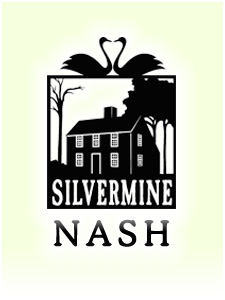Writers were particularly interested in Silvermine and its environs, both for its picturesque setting and its history. In some cases, autobiographical descriptions were included in novels; in others, Silvermine was used as a backdrop or stage set, but was integral to the story nonetheless. A detailed autobiographical sketch of Silvermine was written in 1948 by Adeline Hawkes, entitled The Broom Behind the Door. Hawkes was an orphan who had been adopted by the widow of the founder of Wellesley, Pauline Adeline Durant. Hawkes went to Silvermine as a young child with a nanny named Ada Porter; Porter herself had been adopted, by the Blanchard Fur Mill family in the 1870s. After living in the Blanchard homestead where the current Gutmann house presently stands, she later lived with the Buttery family at what became the Solon Borglum house on Borglum Road. Her last residence in Silvermine was the Sun House, built by John Ryder in 1841, on Comstock Hill Road where the Deering family was in residence in the first decade of the 20th century. The period when her memoir takes place is all the more pertinent by its description of the daily life of a declining mill village. The Sun House is the most documented building from an author’s perspective in Silvermine.
Besides Hawkes, William A. Boring, dean of the Columbia School of Architecture from 1919 to 1931, lived there, followed by Hamilton Hamilton and his daughter Helen Hamilton, both artists. Richardson Wright (1887-1961), the editor-in-chief of House and Garden for more than three decades and one of the most prolific writers on horticulture during the 20th century, lived in the house from 1918 to 1940. Wright was also President of the Silvermine Guild of Artists from 1933 to 1934. Two books written by Wright, Truly Rural (1922) and A Small House and Large Garden (1924) are testaments to the joys of country living and gardening; both books are sprinkled with references to Silvermine as well as to the Sun House itself. In A Small House and Large Garden, Wright describes the Sun House origins and his attempts to give credit to John Ryder in simple, if romanticized, prose. In 1950, a decade after Wright sold the house to Ernest Heyn, the house was purchased by James Scripps Booth, heir to the Scripps-Booth Car Company, acquired by General Motors in 1918. Booth, an artist and engineer, converted the barn into an artist’s studio. Booth sold the house in 1960 to John Harrison Yankee, Jr. and his wife Eileen Heckart (1919-2001). Heckart was an Academy Award-winning actress who starred on Broadway, film and television. Her son, Luke Yankee, published a book in 2006 entitled Just Outside The Spotlight: Growing Up With Eileen Heckart which chronicles not only her acting career but the family’s life living in Silvermine and growing up at the Sun House.
Other authors include Edward Eager, Faith Baldwin, Evan Hungter, and Vance Packark. Edward Eager (1911-1964) was a writer of children’s literature and a lyricist for a number of television productions from the late 1940s until 1963. Of the nine children’s books that he authored, three were located in Silvermine. His stories focused on life in Silvermine during the 1950s, particularly the artists, musicians and writers that lived there. Faith Baldwin (1893-1978) was a prolific author, writing over 100 books during her long career. A longtime resident of Silvermine, six of her novels were set in “Little Oxford,” a fictional version of Silvermine. These books span from The Station Wagon Set (1940), which was set in 1930s, to Any Village (1972). Fable Farm Road off of Silvermine Road is named after her “fables,” as she called her fictional accounts of the Silvermine area. Evan Hunter aka Ed McBain (1926-2005) lived at the Guthrie Mill for decades. Born Salvatore Lombino, he invented the modern police mystery novel, with 72 books written under his Ed McBain name. As Evan Hunter, he wrote an additional 22 books, including his debut, The Blackboard Jungle in 1954. Hunter referred several times to Silvermine in his novels. Finally, an important author who lived in Silvermine but did not write about it was Vance Packard (1914-1996). Packard, who was considered one of the main socialites of Silvermine during his residency there, lived in the Gutmann house for the duration of his stay in Silvermine. A journalist and social critic, Packard created the melding of academic research with popular culture with his groundbreaking book, The Hidden Persuaders (1957).
